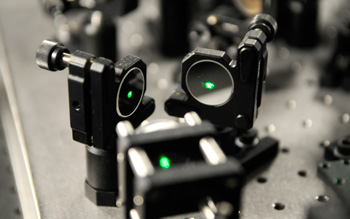科学家最近发现了将量子点(quantum-bits,qubits)由所纠缠的光子(photons)转移到固态结晶存储元件的方法,让宽频量子网络的实现又前进了一小步。通过采用过冷晶体(super-cooled crystal),科学家证实了量子网络波导(quantum network waveguide)的纠缠态量子点,能转移到固态存储,而且此过程是可逆转的。
以上是加拿大卡尔加里大学(University of Calgary)以及德国帕德柏恩大学(University of Paderborn)的合作研究成果;他们发现了光子-光子纠缠与光子还有固态原子激发(excitation of atoms)之间的可逆性转移。以稀土元素(thulium)掺杂铌酸锂(lithium niobate)制成的波导,则用以做为该种光子回波量子存储的通信协定。
另一个来自瑞士日内瓦大学(University of Geneva)的研究团队,也通过过50米的光纤连结完成类似的实验;证实了量子中继器(quantum repeaters)可能将量子网路的超高安全性通信,扩展到任何距离。

量子网络号称可以在完全不用担心有人会监听的状况下传递资讯(照片提供:Riley Brandt)
卡尔加里大学的研究团队已经证实,他们所采用的铌酸锂波导(已经广泛应用在光纤通讯领域),能处理5MHz~5GHz的信号,存储器保留时间为7纳秒(nanosecond);该团队的宽频量子存储器利用现成的铌酸锂晶体,并需要超冷却至零下270摄氏度。接下来,研究团队打算制作一个及时读写通道,采用远距传输(teleportation)来将量子点移进/出固态内存。
“我们已经证实了光子与晶体的原子之间会产生纠缠;下一步我们将以第三个光子进行交互作用,将其状态通过纠缠传输到固态内存中。”卡尔加里大学量子资讯科学研究所(the Institute for Quantum Information Science)教授Wolfgang Tittel表示:“这种传输步骤可望实现未来的超高安全性长距离通信量子网络。”
除此之外,研究团队也计划延长记忆体保留时间,目标是由7纳秒拉长到1秒──这也是采用该种中继器来制作更大型的量子网路的必要条件。
翻译: Judith Cheng
点击进入参考原文:Solid-state quantum memory unveiled
《电子工程专辑》网站版权所有,谢绝转载
{pagination}
Solid-state quantum memory unveiled
R. Colin Johnson
Broadband quantum networks inched closer to reality recently when researchers demonstrated the ability to transfer quantum-bits (qubits) from entangled photons to solid-state crystalline memory devices. Using a super-cooled crystal the researchers were able to demonstrate the reversible transfer of entangled qubits from a quantum network waveguide to the solid-state memory and back again.
Researchers at the University of Calgary (Canada) collaborated with the University of Paderborn (Germany) in the reversible transfer of photon-photon entanglement into entanglement between a photon and the solid-state excitation of atoms. The rare-earth (thulium) doped lithium niobate waveguide made use of the photon-echo quantum memory protocol. Separately, another research group at the University of Geneva (Switzerland) demonstrated a similar capability over a 50-meter fiber optical link, paving the way for quantum repeaters that could extend the ultra-secure communications of a quantum network to any distance.
The University of Calgary team demonstrated that their lithium niobate waveguides, which are already widely used for fiber optic communications, can handle signals from five megahertz to five gigahertz, with a memory retention time of seven nanoseconds. Its broadband quantum memory used off-the-shelf lithium-niobate crystals which needed to be supercooled to minus 270 degrees Celsius. Next, the group plans to create a real-time read-write channel using teleportation to transfer the qubits into and out-of its solid-state memory.
"We have already demonstrated entanglement between a photon and the atoms of the crystal. Our next step will be to use interactions with a third photon to teleport its state into our solid-state memory by virtue of that entanglement," said University of Calgary professor Wolfgang Tittel at the Institute for Quantum Information Science. "This teleportation step will enable future quantum networks that provide ultra-secure long-distance communications."
For the future, besides perfecting teleportation as a means of transferring qubits to and from its quantum memories, the researchers are also planning to extend the memory retention time from seven nanoseconds toward a goal of one second—a necessary condition for using repeaters to create large quantum networks.